THE SCREENING ROOM
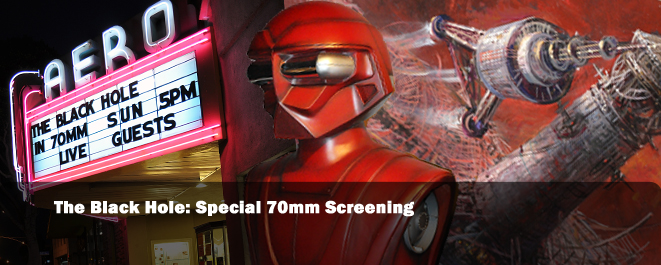
PHOTO GALLERY
By Bill Kallay
Back in those innocent days of my youth, I looked forward to science fiction films like no tomorrow. After a trip to camp during the summer of 1979, where I was terrorized by fictional grizzly bears and awful camp food, I returned home and checked out the mail I missed. On top of my small pile of mail was the new issue of Disney News magazine. At one time, Disney used this magazine as a colorful and informative advertisement for its Magic Kingdom Club members. It was true Disney propaganda, but it was well done and enjoyable to read.On the cover was a slick picture of Disney's new big budget epic, "The Black Hole." I quickly opened it up and read and re-read that article probably 20 times that night. Here was an exciting science fiction blockbuster coming from the same studio that made "Candleshoe." The studio, even in my 11 year-old mind, was growing up and trying something new.
That Christmas, my parents took my three cousins and I to the Cinedome in Orange, California. This was the premiere theater in my neck of the woods and was always a treat to visit. The dome theaters were spectacular and I believe the first time I went to them was to see "Star Trek: The Motion Picture" a few weeks before seeing "The Black Hole" there. The domes had large curved screens and the loudest movie stereophonic sound I'd ever heard since "Close Encounters of the Third Kind."
I had seen the ads for "The Black Hole" on television and had heard about the spectacular visual effects by Disney legend, Peter Ellenshaw and his son, Harrison. I could not wait to see it. I recall being disappointed we had to see the movie in one of the smaller auditoriums at Cinedome, but it was being presented in Dolby Stereo. That I knew was still pretty cool.
The lights faded and the wonderful overture by John Barry played on the big, dark screen. It ended and a computer graphic title blipped across the screen. It was filled with green lines that eventually formed into a black hole that the audience would fly through. I knew this was something totally different from Disney.
The film kept me enthralled. I didn't mind the purposely cartoonish Disney robots like V.I.N.C.E.N.T. and B.O.B. The large red robot, Maximillian, scared the crud out of me. I didn't seem to mind the often silly dialogue. Maximillian Schell's overacting seemed fine to me. I thought the cast was kind of old, except for Joseph Bottoms. But the laser gun fights and the spectacular visual effects really knocked me for a loop. The U.S.S. Cygnus was simply stunning and I'd never seen a film that made outer space look so beautifully haunting. Gary Nelson's direction was solid. The film's ending, though confusing, was still a trip I'd never forget.
Not too long after the film left theaters after a successful run (though not as big as "ST:TMP"), I caught it on an old cable channel called ON TV. And when we got our first VCR, my parents bought me the VHS cassette with a V.I.N.C.E.N.T. Christmas tree ornament. They even bought me the action figures of he and Maximillian. You could say the film, despite its flaws in scripting, had a place in my heart.
AMERICAN CINEMATHEQUE 70MM SCREENING
What a surprise that the American Cinematheque in Santa Monica, California, had a special 70mm screening of this long lost Disney film. When I saw it in 1979, it was in 35mm Dolby Stereo. Later on, Disney paired the film with "Sleeping Beauty" in special 70mm screenings in the Los Angeles/Orange County region. The double-feature did well, actually. So for me to finally see it in its pristine form was going to be special. In addition, Harrison Ellenshaw would be on hand to field a barrage of questions from the audience over that ending.
The screening was held on June 13, 2010. It was co-sponsored by the Visual Effects Society and Griffith Observatory.
Walking into the lobby of the Aero Theatre, audience members were surrounded by a number of stunning boards featuring artwork from the film. Host Gene Kozicki had specially prepared these boards, as well as set up the display of one of the Sentry Robots.
The screening was nearly filled to capacity. The lights faded and the haunting John Barry overture played. The print runs on the screen, but it is usually pitch black if the print is in good shape. Unfortunately, the screen was pink. Very pink. I figured that by the time the reel ran a bit, it would clear up. The memorable title sequence came up and the print improved a bit, but not by much. In fact, the center channel at one point suddenly went down to barely audible, then finally picked up and remained for the rest of the movie. The sound was sparkled with pops and static on the magnetic tracks. As I recall, even on the 35mm version I saw as a kid, it was a dynamic and powerful soundtrack.
The print was in terrible shape. Though I'm glad to see the film in 70mm, it's a shame that Disney let it get to this condition. A few years ago, I saw "Sleeping Beauty" at El Capitan in Hollywood and the restored 1996 print was already showing signs of abuse. "The Black Hole" was a very sharp and nearly grain-free movie from what I remember. Ellenshaw backs this up by saying, "It WAS grain-free!"
What a sad commentary on how a large studio like Disney, who is known for taking pretty good care of its film library, let this one slip. Both Ellenshaw's work, and the fine cinematography by Frank V. Phillips, ASC, deserved a better presentation. The audience, despite howling at some of the silly dialogue, missed some truly great visual effects work shown the right way. Both Ellenshaws, along with Art Cruickshank, Eustace Lycett, Danny Lee and Joe Hale, were nominated for their visual effects work. Phillips was nominated for Cinematography.
Ellenshaw graciously took the stage, along with Dr. Laura Danly of the Griffith Observatory and moderator Kozicki. Though Kozicki poked fun at the dialogue, the movie, and even some of the visual effects, Ellenshaw humorously explained why some things came to be on the film.
THE WIRES AND INCREDIBLE MATTES
Before "TRON" introduced the world to CGI in a big way, "The Black Hole" had to suspend the actors and robots on wires. Ellenshaw emphasized that there wasn't any digital wire removal back in the late '70s. Even back when the film was considered state-of-the-art, audiences still couldn't get past the wire work. Ellenshaw pointed out that they actually built some sets upside down so that the robot wires couldn't be seen as clearly and did what they could to hide the wires.
The film featured some of the most impressive matte paintings ever committed to a film. Harrison Ellenshaw painted most of them, in addition to aiding his pop in painting the massive star fields. Some of his mattes that really standout include the reveal shot as the Palamino crew enters the Cygnus bridge, the massive middle interior of the Cygnus, and the subtle yet impressive "garden room" in which Ernest Borgnine discovers Dr. Reinhardt's secret garden. Many of those mattes still look incredibly realistic today.
THE BLACK HOLE
Dr. Danly pointed out, with a grin, that much of the science used in the film wasn't accurate. I'm no scientist, but from what I gathered, the way Peter Ellenshaw beautifully rendered outer space isn't necessarily what the crew of the U.S.S. Palomino would've seen. Space is apparently jet black and black holes wouldn't necessarily appear as they do in the film. Yet one cannot disagree with how it was shown. Space is very striking in Ellenshaw's production design.
CARTOONISH ROBOTS
When the film came out, it was criticized for the robots not only being "rip-offs" from "Star Wars," but also of being too Disney-esque. Truth be told, the film was planned almost two years before "Star Wars" came out. As for the robots of "The Black Hole," they were intended to be that way. The film got some unfair flack for that. After all, R2D2 was childlike in design and how he spoke and everybody loved that rolling trashcan. What made V.I.N.C.E.N.T. and B.O.B. appealing were the voices of McDowell and Pickens. I still think George F. McGinnis' robot designs were fun.
THE ENDING
The ending threw audiences into the black hole along with the survivors of the Palamino. Both came out of it somewhat confused. The journey was almost as trippy as the ending in "2001: A Space Odyssey." What did it all mean?
Ellenshaw said that when it came around to how to end the movie, they couldn't. There was no written ending! Harrison then suggested an ambitious climax that involved the journey through the black hole, into a long zoom shot going from Dr. Kate McCrae's (Yvette Mimieux) eye to reveal her gazing at Michelangelo's painting on the Sistine ceiling. Now that would've really blown audiences away! Instead, we got the incredible hell versus heaven ending. Still confusing, yet undeniably ambitious for a Disney film of that period.
IN HINDSIGHT
The film was flawed, sure. It heavily borrowed story elements from "20,000 Leagues under the Sea." But it certainly showed that Disney was trying to break out of its '70s "play it safe" mode. It led to many great steps in turning the company around. The promotion of a young executive named Tom Wilhite started the company on an incredible journey. He in turn put into production "Tron," "Tex," "Never Cry Wolf," and encouraged budding artists like John Lasetter and Tim Burton to experiment.
As for "The Black Hole," it's considered one of those guilty Disney pleasures. It's easy to criticize the film today with our cynical view. Kozicki got some good laughs pointing out the aluminum foil wrapping job done on Yvette Mimieux. But looking back and realizing just how much talent and ambition was involved, the film really was a crucial turning point in Disney and visual effects. It showed that Disney was capable of mounting an epic and somewhat more adult film. It showed Disney's prowess in visual effects under the leadership of the Ellenshaws. It also marked a transition from traditional effects into CGI. Disney's next big adventure would herald in the age (eventually) of computer animation and effects. That adventure was "Tron" in 1982.
Below is a photo gallery of the screening and some preproduction and production artwork from the film.
PHOTO GALLERY
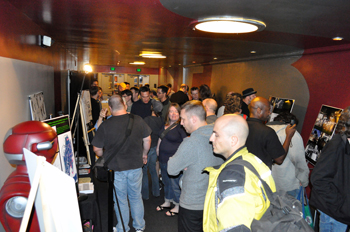 Crowd checks out the displays |
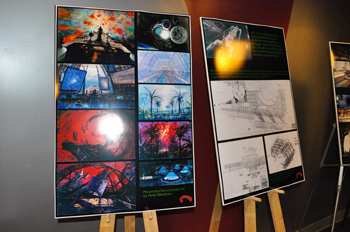 Just some of Peter Ellenshaw's preproduction artwork |
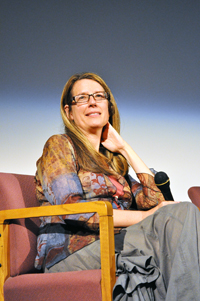 Dr. Laura Danly of the Griffith Observatory |
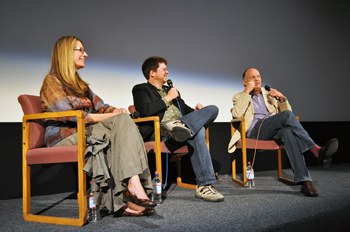 Dr. Laura Danly, moderator Gene Kozicki and Harrison Ellenshaw |
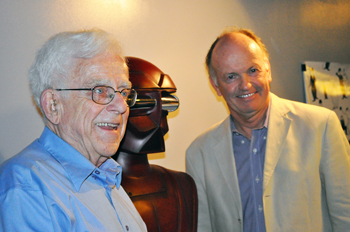 Designer of the robots, George F. McGinnis, and Ellenshaw. McGinnis was also a top designer with Disney Imagineering having worked on many attractions including Space Mountain |
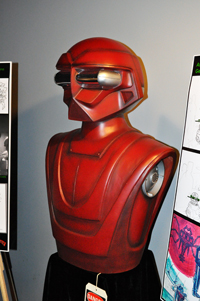 Sentry stands guard outside of the auditorium, minus arms and legs |
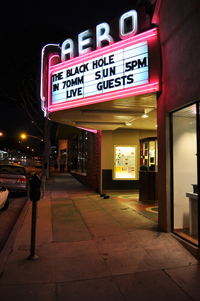 Aero marquee |
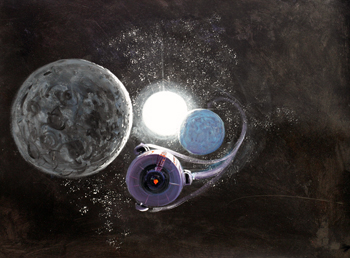 Early rendition of the U.S.S. Palomino |
 Another version of the U.S.S. Palomino |
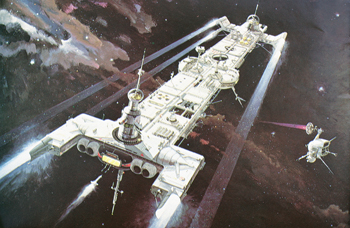 The U.S.S. Cygnus blasts through space |
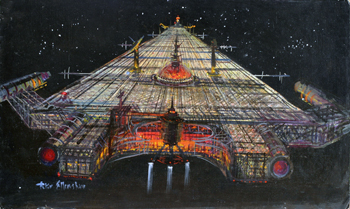 Peter Ellenshaw's elegant design |
 Above view schematic of the Cygnus [Enlarge] |
 (left to right) Harrison and Peter Ellenshaw work on the huge Cygnus model |
 Harrison contemplates how the film will end |
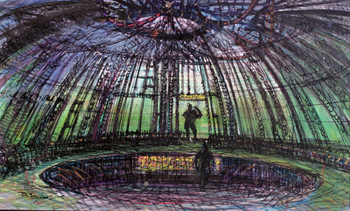 The Green House |
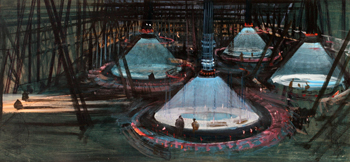 The robot factory |
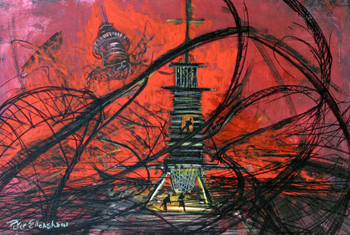 Destruction of the Cygnus |
 The probe ship escapes |
Special thanks to Harrison Ellenshaw
Photos: © 2010 Bill Kallay. All rights reserved. Artwork and "The Black Hole" photos © Disney, artwork illustrated by Peter Ellenshaw. All rights reserved.
About | Site Index | Contact | Terms & Conditions | Links

Custom Search